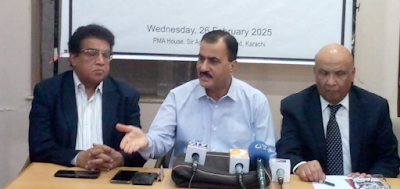Prevalence of hepatitis, HIV among blood donors ‘on the rise’
By Sabahat Muslim
KARACHI:
Blood samples of as many as 159,665 (3.80%) screened healthy donors of the
Sindh Blood Transfusion Authority (SBTA) regulated 185 blood banks were found
positive for transfusion transmitted illnesses (TTIs) during a period of five
years across Sindh, revealed a lately released medical science research report.
According
to the doctors who conducted the said study to assess the prevalence and
distribution of TTIs among healthy blood donors, there has been a considerable
increase in the number of Hepatitis B or C and HIV (Human Immunodeficiency
Virus) among blood donors in Sindh, which underscores the need for continued
surveillance, prevention and intervention to address the issue.
The
research report, showing a continuously increasing trend of all the mentioned
infections, has been published in Cureus Journal of Medical Science, an
online open access multi-specialty journal.
A team comprising Dur-e-Naz Jamal and Sundas Gul of SBTA, Samra Waheed of Regional Blood Centre, Karachi, and Maria Ali of the National Institute of Cardiovascular Diseases, in its report, also recommended for the promotion of voluntary blood donors and screening of donated blood through a highly sensitive screening assay—nucleic acid testing.
“There should be centralised blood collection systems having better personnel and equipment, and non-remunerated voluntary blood donations must be strongly encouraged,” the researchers added.
According to the researchers, the total number of blood donations in the blood banks across the province showed a progressive increase from 22,822 donors in 2018 to 937,039 donors in 2022.
Among the
donors screened from the said period, 3,821,268 (91%) were replacement donors
while only 377,927 (9%) were voluntary donors. The replacement donors were
family members, friends, or relatives of the patients concerned.
“Among
them 3,870,598 (92.2%) were males and only 3,285,97 (7.8%) were females”, the
report said, adding most of the donors (2,664,648) were in the age bracket of
29-39 years.
Samples of
the blood donated in Sindh was tested by enzyme-linked immunosorbent assay
(ELISA) or chemiluminescent immunoassay (CLIA) blood centres running under the
umbrella of SBTA.
Describing
the protocols observed for collection of blood at the registered blood banks,
the research report stated that the potential donors undergo a questionnaire
and a physical examination performed by trained physicians. As per eligibility
criteria, a blood donor should be apparently healthy, being between 18 and 60
years of age, having at least a 12.5 hemoglobin level, and weighing above
50 kg. People with high-risk behaviour or any other deferral cause were
excluded from the study.
After a
retrospective cross-sectional study of the entire blood donors, aged 18 to 60
years, during the period of five years, 81,266 (1.94%) tested positive for
hepatitis C, 71,688 (1.7%) tested positive for hepatitis B and 6,711 (0.15%)
tested positive for HIV.
The study
evaluated the annual prevalence of HCV, HBV, and HIV in blood donors at the
respective blood banks and overall. “The prevalence of HCV was recorded ranging
from 12,007 (1.46%) in 2018 to 20,863 (2.22%) in 2022. There was a 38.4%
increase in frequency initially from 2018 to 2019, a slight decrease in cases
from 2019 to 2020, most likely due to the Covid wave, and a surprising 55.6%
increase in HCV cases from 2020 to 2021. A 7.9% increase was observed from 2021
to 2022 with 20,863 (2.22%) positive cases in 2022.”
The prevalence
of HBV among blood donors in 2018 was 10,270 accounting for 1.25% of the total
screened, which increased gradually during 2018 and 2019 with a surprising
56.6% increase, the report maintained. The rate decreased from the year 2019 to
2020 by 16%, while again there was a percentage rise between 2020 and 2021 and
then there was a 4.5% decrease in the following year 2022.
“The
prevalence of HIV among blood donors in 2018 was 545, accounting for 0.07% of
the total screened. The positive cases increased rapidly in 2019 and 2020.
In 2021, there was a 40% decrease in cases from 2,234 to 1,329. There was
a 13% rise between 2021 and 2022.
The risk
of acquiring blood-borne diseases is higher in developing countries due to the
higher prevalence of TTIs among the donors and the lack of proper practices in
blood screening, the report quoted a previous research, adding that there is a
significant need for blood due to a high prevalence of blood disorders such as
thalassemia and hemophilia, as well as the demands for hemodialysis, and during
pregnancy, surgical procedures, accidents, and emergencies.
The
researchers also mentioned in their report that the ideal population for the
seroprevalence of the infectious studies is the general population, but in view
of the non-feasibility they took the healthy donor population only in their
research.
Highlighting
the limitations of researchers, the report said that the analysis for the
research was conducted on the data provided by different blood banks to SBTA,
while no secondary verification could be done for confirmation of the screening
test results.
Courtesy: Social Track, weekly.




Comments
Post a Comment